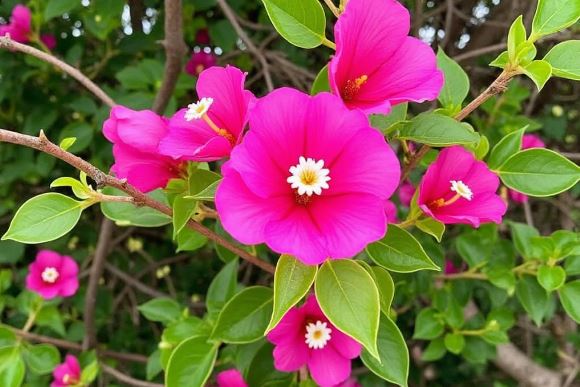
Bougainvillea peruviana is a species of the flowering plant genus Bougainvillea, which is part of the Nyctaginaceae family. It’s a woody vine with a sprawling or climbing habit, often used in gardens to cover walls, fences, or trellises. The leaves are green, ovate to elliptic in shape.
What most people refer to as the “flowers” of bougainvillea are actually bracts, which are specialized leaves that surround the small, inconspicuous true flowers. In Bougainvillea peruviana, these bracts can be various shades of pink or magenta, though they might be less vibrant compared to some hybrid varieties.
Bougainvillea peruviana is often used in landscaping for its vibrant color display, drought tolerance, and ability to cover large areas. It’s popular in Mediterranean, tropical, and subtropical gardens. In many cultures, bougainvillea symbolizes welcome, peace, and the inviting beauty of a home or garden.
It can be susceptible to pests like aphids, caterpillars, and mites, and occasionally to fungal diseases if overly watered or if there’s poor air circulation.
Characteristics
- Color: This species typically features bracts in shades of pink to magenta, though there might be variations due to cultivation or hybrid forms. The small white flowers are less noticeable than the vibrant bracts.
- Growth Habit: B. peruviana is less aggressive in growth compared to some other species but can still become quite sizable, reaching up to 15-20 feet if allowed to climb or spread. It’s often more shrub-like in its natural form.
- Leaves: The leaves are green and can be slightly more rounded than those of other bougainvillea species, with a somewhat velvety texture due to fine hairs.
- Thorns: It has thorns, though they might be less pronounced or fewer in number compared to species like B. spectabilis.
- Blooming Period: Flowers in cycles, particularly in response to dry periods followed by rain, which can induce blooming. In ideal conditions, it can bloom almost year-round.
- Hardiness: Suitable for USDA zones 10-11. It’s sensitive to frost and cold temperatures.
Cultivation
- Light: Thrives in full sun. A position with at least 6 hours of direct sunlight ensures the best floral display.
- Soil: Prefers well-drained soil, with a slight preference for sandy or loamy soils. Good drainage is essential to prevent root rot.
- Watering: Once established, B. peruviana shows good drought tolerance. Water deeply but allow the soil to dry out between watering sessions to promote flowering and prevent root diseases.
- Fertilization: Use a balanced fertilizer during the growing season, or one higher in phosphorus to encourage blooming. Over-fertilization, especially with nitrogen, can lead to excessive leaf growth over flowers.
- Pruning: Can be pruned to shape or to encourage bushier growth. Pruning after a bloom cycle helps promote new growth that will bear flowers.
- Support: Though it can grow as a shrub, providing support can help it climb or spread in a controlled manner, useful for landscaping design.
- Cold Protection: In regions where temperatures drop, it should be protected from frost. In colder climates, it’s better grown in containers that can be moved indoors during winter.
- Propagation: Propagation can be done through hardwood cuttings taken during the dormant season or semi-hardwood cuttings in the growing season, often with the use of rooting hormones to increase success rates.